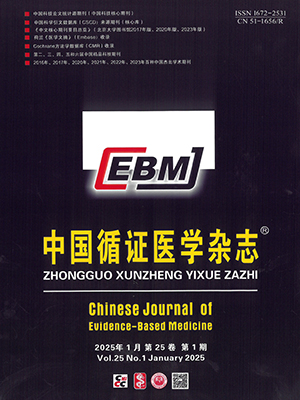| 1. |
Parkin DM, Bray F, Ferlay J, et al. Global cancer statistics, 2002. CA Cancer J Clin, 2005, 55(2): 74-108.
|
| 2. |
Yang L, Parkin DM, Li LD, et al. Estimation and projection of the national profile of cancer mortality in China: 1991-2005. Br J Cancer, 2004, 90(11): 2157-2166.
|
| 3. |
Rivera MP. Multimodality therapy in the treatment of lung cancer. Semin Respir Crit Care Med, 2004, 25 Suppl 1: 3-10.
|
| 4. |
乔贵宾, 吴一龙. 酪氨酸激酶受体信号传导通路与肺癌的靶向治疗. 中国处方药, 2005, 5(38): 14-17.
|
| 5. |
杨学宁, 吴一龙. 口服小分子靶向治疗药物吉非替尼. 临床药物治疗杂志, 2005, 3(2): 56-59.
|
| 6. |
Fukuoka M, Yano S, Giaccone G, et al. Multi-institutional randomized phase II trial of gefitinib for previously treated patients with advanced non-small-cell lung cancer (The IDEAL 1 Trial). J Clin Oncol, 2003, 21(12): 2237-2246.
|
| 7. |
Kris MG, Natale RB, Herbst RS, et al. Efficacy of gefitinib, an inhibitor of the epidermal growth factor receptor tyrosine kinase, in symptomatic patients with non-small cell lung cancer: a randomized trial. JAMA, 2003, 290(16): 2149-2158.
|
| 8. |
Giaccone G, Herbst RS, Manegold C, et al. Gefitinib in combination with gemcitabine and cisplatin in advanced non-small-cell lung cancer: a phase III trial--INTACT 1. J Clin Oncol, 2004, 22(5): 777-784.
|
| 9. |
Herbst RS, Giaccone G, Schiller JH, et al. Gefitinib in combination with paclitaxel and carboplatin in advanced non-small-cell lung cancer: a phase III trial--INTACT 2. J Clin Oncol, 2004, 22(5): 785-794.
|
| 10. |
Thatcher N, Chang A, Parikh P, et al. Gefitinib plus best supportive care in previously treated patients with refractory advanced nonsmall- cell lung cancer: results from a randomised, placebocontrolled, multicentre study (Iressa Survival Evaluation in Lung Cancer). Lancet, 2005, 366(9496): 1527-1537.
|
| 11. |
Kelly K, Chansky K, Gaspar LE, et al. Phase III Trial of Maintenance Gefitinib or Placebo After Concurrent Chemoradiotherapy and Docetaxel Consolidation in Inoperable Stage III Non–Small- Cell Lung Cancer: SWOG S0023. J Clin Oncology, 2008, 26(15): 2450-2456.
|
| 12. |
Cufer T, Vrdoljak E, Gaafar R, et al. Phase II, open-label, randomized study (SIGN) of single-agent gefitinib (IRESSA) or docetaxel as second-line therapy in patients with advanced (stage IIIb or IV) non-small-cell lung cancer. Anticancer Drugs, 2006, 17(4): 401-9.
|
| 13. |
Kim ES, Hirsh V, Mok T, et al. Gefitinib versus docetaxel in previously treated non-small-cell lung cancer (INTEREST): a randomised phase III trial. Lancet, 2008, 372(9652): 1809-1818.
|
| 14. |
管忠震, 张力, 李龙芸, 等. 吉非替尼治疗局部晚期或转移性非小细胞肺癌在中国的临床研究. 癌症, 2005, 24(8): 980-984.
|
| 15. |
张阳, 张力, 徐菲, 等. 吉非替尼记名供药计划(EAP)治疗晚期非小细胞肺癌患者的临床研究结果. 癌症, 2006, 25(12): 1561-1564.
|
| 16. |
张康, 左强, 罗荣城. 吉非替尼治疗36例晚期非小细胞肺癌. 中国癌症杂志, 2006, 16(10): 878-879.
|
| 17. |
谢晓冬, 郑振东, 刘大为, 等. 吉非替尼(Iressa)治疗晚期复治非小细胞肺癌的临床观察. 中国肿瘤临床, 2006, 33(10): 574-576.
|
| 18. |
徐建明, 李月敏, 刘晓晴, 等. 吉非替尼治疗晚期非小细胞肺癌的临床研究. 中华肿瘤杂志, 2007, 29(1): 66-69.
|
| 19. |
张品良, 陈黎. 吉非替尼治疗晚期非小细胞肺癌53例临床观察. 临床肿瘤学杂志, 2006, 11(9): 690-693.
|
| 20. |
王彬, 张湘茹, 储大同. 易瑞沙在晚期非小细胞肺癌化疗失败后的作用. 中华肿瘤杂志, 2004, 26(12): 742-745.
|
| 21. |
刘莹, 谢小云. 单用吉非替尼对非小细胞肺癌的疗效评价. 中国医院药学杂志, 2007, 27(7): 924-926.
|
| 22. |
谢晓冬, 郑振东, 屈叔贤, 等. 吉非替尼治疗非小细胞肺癌51例疗效观察. 沈阳部队医药, 2007, 20(4): 247-249.
|
| 23. |
郑迪, 山鸟忠宏, 平岛智德, 等. 吉非替尼单药治疗化疗失败的晚期非小细胞肺癌31例. 中国新药杂志, 2004, 13(6): 553-555.
|
| 24. |
张翠英, 杨宏, 陈彦俊. 吉非替尼治疗晚期非小细胞肺癌32例. 内蒙古医学杂志, 2007, 39(4): 439-441.
|
| 25. |
霍伟, 冯仲珉, 赵卫红, 等. 吉非替尼治疗晚期非小细胞肺癌64例. 临床肿瘤学杂志, 2005, 10(1): 4-7.
|
| 26. |
冯仲珉, 刘艳娥, 孙利敏. 吉非替尼治疗晚期非小细胞肺癌的临床研究. 大连医科大学学报, 2007, 29(6): 546-549.
|
| 27. |
郑航, 陈锦章, 罗荣城. 吉非替尼治疗晚期非小细胞肺癌的临床研究. 临床肿瘤学杂志, 2006, 11(10): 744-746.
|
| 28. |
吴凤坚, 陈广幸, 汪森明, 等. 吉非替尼治疗晚期非小细胞肺癌疗效观察. 现代医药卫生, 2006, 22(21): 3293-3294.
|
| 29. |
张晓彤, 李龙芸, 王树兰, 等. 吉非替尼治疗晚期非小细胞肺癌疗效观察. 中华结核和呼吸杂志, 2005, 28(3): 180-183.
|
| 30. |
徐艳霞, 徐媺, 高炜. 吉非替尼治疗晚期复治的非小细胞肺癌的临床观察. 药物与临床, 2007, 4(14): 48-49.
|
| 31. |
林琳, 王彬, 张湘茹, 等. 易瑞沙在24 例化疗后进展的晚期非小细胞肺癌中的作用. 中国肺癌杂志, 2006, 9(3): 280-282.
|
| 32. |
王巍, 邓燕明, 胡斌. 易瑞沙治疗化疗失败的晚期非小细胞肺癌. 实用癌症杂志, 2007, 22(6): 614-616.
|
| 33. |
凌扬, 徐建忠, 杨全良, 等. 易瑞沙治疗化疗失败非小细胞肺癌的临床观察. 肿瘤防治杂志, 2005, 12(18): 1413-1414. .
|
| 34. |
周浩本, 周世繁, 王居峰, 等. 易瑞沙治疗晚期非小细胞肺癌临床观察. 中华肿瘤防治杂志, 2006, 13(22): 1759.
|
| 35. |
郑华, 王敬萍. 吉非替尼(Iressa)在晚期肺腺癌的靶向治疗疗效观察. 中国肺癌杂志, 2007, 10(3): 229-233.
|
| 36. |
张莉, 于世英. 吉非替尼单药治疗晚期非小细胞肺癌. 中华肿瘤杂志, 2006, 28(7): 539-541.
|
| 37. |
夏国豪, 史美祺, 江伟, 等. 吉非替尼治疗化疗失败的晚期非小细胞肺癌38例. 肿瘤基础与临床, 2007, 20(5): 390-392.
|
| 38. |
张志豪, 杜开齐, 朱有才, 等. 吉非替尼治疗23例晚期非小细胞肺癌. 中国癌症杂志, 2007, 17(11): 894-896.
|
| 39. |
杨鹭, 刘叙仪, 方健, 等. 吉非替尼治疗91例晚期非小细胞肺癌疗效分析. 中国肿瘤杂志, 2006, 28(6): 474-477.
|
| 40. |
温浙盛, 陈晓勤, 吴海鹰, 等. 吉非替尼治疗不同类型晚期非小细胞肺癌患者的疗效比较. 癌症, 2007, 26(4): 415-417.
|
| 41. |
张燕, 陈黎, 张品良, 等. 吉非替尼治疗难治性非小细胞肺癌的疗效. 中国新药与临床杂志, 2006, 25(3): 196-199.
|
| 42. |
贾国强, 杨亚青. 吉非替尼治疗非小细胞肺癌的临床疗效观察. 药学实践杂志, 2007, 25(6): 399-400.
|
| 43. |
王燕, 王颖, 王彬, 等. 吉非替尼治疗非小细胞肺癌脑转移的初步结果. 中国肺癌杂志, 2006, 9(5): 447-451.
|
| 44. |
郭宇玲, 孙哲, 李艳茹. 吉非替尼治疗复治晚期非小细胞肺腺癌12例. 肿瘤学杂志, 2006, 12(6): 512.
|
| 45. |
吕蕾, 缪建华, 陈暑波, 等. 吉非替尼联合艾迪治疗老年非小细胞肺癌的临床研究. 齐齐哈尔医学院学报, 2006, 27(17): 2057-2059.
|
| 46. |
钱军, 秦叔逵, 杨柳青, 等. 吉非替尼联合康莱特治疗中晚期非小细胞肺癌的临床研究. 临床肿瘤学杂志, 2004, 9(6): 568-570.
|
| 47. |
苏安, 吕霞, 王馨, 等. 吉非替尼与多烯紫杉醇二线治疗Ⅳ期肺腺癌疗效比较. 实用癌症杂志, 2007, 22(6): 617-619.
|
| 48. |
孙利敏. 吉非替尼改善晚期非小细胞肺癌患者生活质量的临床分析. 大连医科大学学报, 2007, 29(5): 483-490.
|
| 49. |
胡洪林, 邓颖, 任刚, 等. 吉非替尼治疗晚期非小细胞肺癌临床疗效分析. 实用医院临床杂志, 2007, 4(5): 36-38.
|
| 50. |
Gridelli C, Ardizzoni A, Ciardiello F, et al. Second-line treatment of advanced non-small cell lung cancer. J Thorac Oncol, 2008, 3(4): 430-440.
|
| 51. |
郭荣荣, 徐风华, 孙华燕. 多烯紫杉醇作为晚期非小细胞肺癌的二线治疗药物的系统评价. 中国循证医学杂志, 2008, 8(10): 861-868.
|
| 52. |
Parikh P, Chang AY, Nag S, et al. Clinical experience with gefitinib in Indian patients. J Thorac Oncol, 2008, 3(4): 380-385.
|
| 53. |
Wu YL, Zhong WZ, Li LY, et al. Epidermal growth factor receptor mutations and their correlation with gefitinib therapy in patients with non-small cell lung cancer: a meta-analysis based on updated individual patient data from six medical centers in mainland China. J Thorac Oncol, 2007, 2(5): 430-439.
|
| 54. |
Hirsch FR, Varella-Garcia M, Bunn PA Jr, et al. Molecular predictors of outcome with gefitinib in a phase III placebo-controlled study in advanced non-small-cell lung cancer. J Clin Oncol, 2006, 24(31): 5034-5042.
|
| 55. |
Paez JG, Jänne PA, Lee JC, et al. EGFR mutations in lung cancer: correlation with clinical response to gefitinib therapy. Science, 2004, 304(5676): 1497-1500.
|
| 56. |
潘振奎, 张力, 张星, 等. 中国非小细胞肺癌患者表皮生长因子受体突变的研究. 癌症, 2005, 24(8): 919-923.
|




